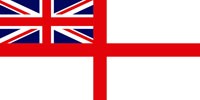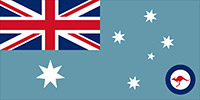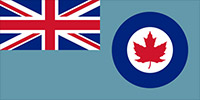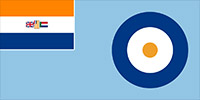 |
 |
 |
 |
 |
 |
849 NAVAL AIR SQUADRON
Motto: - 'Primus video - The first to see'
Role: - Aircrew and Maintainer Training Squadron for Sea King ASaCS Mk 7
Base: - RNAS Culdrose
SQUADRON HISTORY
849 Squadron first formed in 1943 with Avenger torpedo, strike and reconnaissance aircraft but has its origins with the Naval Wing of the Royal Flying Corps from 1912. Seconded to Coastal Command, they supported Operation Overlord, the D-Day landings.
The Squadron disbanded at the end of the war but was reformed in 1952 to perform the new Airborne Early Warning role. The first of 50 Douglas Skyraiders, fitted with long range radar, had been delivered in 1951. Airborne Early Warning embarked for the first time on a carrier in September 1952.
The rebirth of Airborne Early Warning in the Royal Navy occurred in 1982 as a result of the Falklands War. The first two helicopters to be converted to carry the Thorn EMI Searchwater radar were completed in just 90 days. They returned to RNAS Culdrose later in 1982 to continue trials. In 1984, the concept having been proved, 849 Squadron was commissioned.
World War two
849 Naval Air Squadron was formed on 1 August 1943 at the Naval Air Station Quonset Point, Rhode Island with Grumman Avenger Is. It returned to the UK and provided anti-surface vessel and anti-submarine patrols over the English Channel prior to and during the D-Day operations.
In August 1944, it was sent to Ceylon to join the British Eastern Fleet, embarking on HMS Victorious (and becoming part of the British Pacific Fleet in November 1944). It took part in Operation Lentil against oil installations at Pangkalan Brandan in Sumatra on 4 January 1945, and in the larger carrier strikes against the oil refineries at Palembang Sumatra (Operation Meridian) on 24 and 29 January.
Victorious, including 849 in its Carrier Air Group, took part in operations in support of the American invasion of Okinawa from March to May 1945, flying strikes against airfields used by Japanese Kamikaze aircraft on the Sakishima Islands and on Formosa. Still aboard Victorious, No. 849 took place in raids against the Japanese Home islands in July and August, including the bombing raids on 24 July that resulted in severe damage to the Japanese escort carrier Kaiyo. It disbanded on 31 October 1945.
Airborne Early Warning (1953-78)
The squadron reformed at Royal Naval Air Station (RNAS) Culdrose on 7 July 1953, being equipped with ex United States Navy Douglas Skyraider AD4W as an Airborne Early Warning unit, from 778 Naval Air Squadron. These were operated by squadron detachments assigned to the Royal Navy's aircraft carriers HMS Ark Royal, Bulwark, Eagle, Hermes and Victorious.
Following the retirement of the Skyraiders in December 1960, the unit flew the Fairey Gannet AEW.3 in the same role, operating from HMS Eagle, Ark Royal, Centaur, Hermes and Victorious. Gannet AS.4, COD.4 and T.5s were also operated in supporting roles. The squadron detachments continued as 849B (Ark Royal) and 849HQ (RAF Lossiemouth), until the squadron disbanded again on 15 December 1978.
In November 1970 Bristol Belle, one of the first hot air balloons to fly in UK, was piloted by Lt Terry Adams, accompanied by Lt Howard Draper both of 849 Squadron B Flight (Gannets). This early morning launch carried mail into Malta whilst the Ark Royal was steaming off the southern coast of that island.
Helicopter AEW (1984 to 2018)
It reformed after the lessons of the 1982 South Atlantic campaign had been learned, on 8 November 1984 and the unit then operated the Westland Sea King Mk7 Airborne Surveillance and Control (ASaC) helicopter. The squadron was stationed at RNAS Culdrose in Cornwall, operating 9 aircraft. It was divided into three elements - two flights (A and B), or Aardvarks and Bees and the Operational Conversion Unit (OCU)(Previously known as HQ). Historically, a Flight was assigned to each of the two active aircraft carriers in the Royal Navy. The squadron suffered heavy losses during the 2003 invasion of Iraq when two of its aircraft operating from HMS Ark Royal collided during low visibility conditions. Six squadron members and an American exchange officer were killed in the collision.
On 13 December 2006, after a short ceremony at RNAS Culdrose, A Flight became 854 Squadron and B Flight became 857 Squadron, taking the former's Sea King ASaC.7 with them.
In May 2014, the MOD announced that seven ASaC.7 helicopters, to be operated by 849 Naval Air Squadron, would remain in service with the RN through to the second half of 2018; the remainder of the Royal Navy's Sea Kings, of all types, were to be withdrawn by 2016.
854 and 857 Naval Air Squadrons were reabsorbed by 849 Naval Air Squadron in 2015, to form 'Normandy' and 'Palembang' flights respectively. The third flight in 849 NAS is 'Okinawa Flight'.
Decommissioning
849 NAS decommissioned on 21 April 2020.
PREVIOUS AIRCRAFT TYPES
Avenger, Skyraider, Gannet , Sea King
BATTLE HONOURS
Normandy 1944, Palembang 1945, Japan 1945, Okinawa 1945

 Editor for Asisbiz: Matthew Laird Acred
Editor for Asisbiz: Matthew Laird Acred
If you love our website please add a like on facebook
Please donate so we can make this site even better !!
